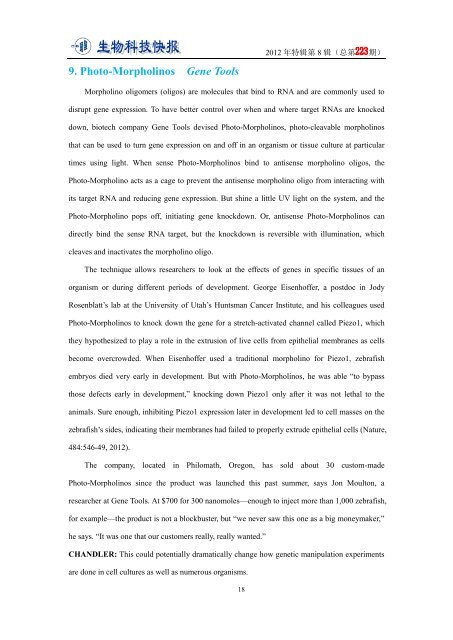2012 生命科学10 大创新 - 中国科学院成都生物研究所科技信息情报中心
2012 生命科学10 大创新 - 中国科学院成都生物研究所科技信息情报中心
2012 生命科学10 大创新 - 中国科学院成都生物研究所科技信息情报中心
Create successful ePaper yourself
Turn your PDF publications into a flip-book with our unique Google optimized e-Paper software.
<strong>2012</strong> 年 特 辑 第 8 辑 ( 总 第 期 )<br />
9. Photo-Morpholinos Gene Tools<br />
Morpholino oligomers (oligos) are molecules that bind to RNA and are commonly used to<br />
disrupt gene expression. To have better control over when and where target RNAs are knocked<br />
down, biotech company Gene Tools devised Photo-Morpholinos, photo-cleavable morpholinos<br />
that can be used to turn gene expression on and off in an organism or tissue culture at particular<br />
times using light. When sense Photo-Morpholinos bind to antisense morpholino oligos, the<br />
Photo-Morpholino acts as a cage to prevent the antisense morpholino oligo from interacting with<br />
its target RNA and reducing gene expression. But shine a little UV light on the system, and the<br />
Photo-Morpholino pops off, initiating gene knockdown. Or, antisense Photo-Morpholinos can<br />
directly bind the sense RNA target, but the knockdown is reversible with illumination, which<br />
cleaves and inactivates the morpholino oligo.<br />
The technique allows researchers to look at the effects of genes in specific tissues of an<br />
organism or during different periods of development. George Eisenhoffer, a postdoc in Jody<br />
Rosenblatt’s lab at the University of Utah’s Huntsman Cancer Institute, and his colleagues used<br />
Photo-Morpholinos to knock down the gene for a stretch-activated channel called Piezo1, which<br />
they hypothesized to play a role in the extrusion of live cells from epithelial membranes as cells<br />
become overcrowded. When Eisenhoffer used a traditional morpholino for Piezo1, zebrafish<br />
embryos died very early in development. But with Photo-Morpholinos, he was able “to bypass<br />
those defects early in development,” knocking down Piezo1 only after it was not lethal to the<br />
animals. Sure enough, inhibiting Piezo1 expression later in development led to cell masses on the<br />
zebrafish’s sides, indicating their membranes had failed to properly extrude epithelial cells (Nature,<br />
484:546-49, <strong>2012</strong>).<br />
The company, located in Philomath, Oregon, has sold about 30 custom-made<br />
Photo-Morpholinos since the product was launched this past summer, says Jon Moulton, a<br />
researcher at Gene Tools. At $700 for 300 nanomoles—enough to inject more than 1,000 zebrafish,<br />
for example—the product is not a blockbuster, but “we never saw this one as a big moneymaker,”<br />
he says. “It was one that our customers really, really wanted.”<br />
CHANDLER: This could potentially dramatically change how genetic manipulation experiments<br />
are done in cell cultures as well as numerous organisms.<br />
18








